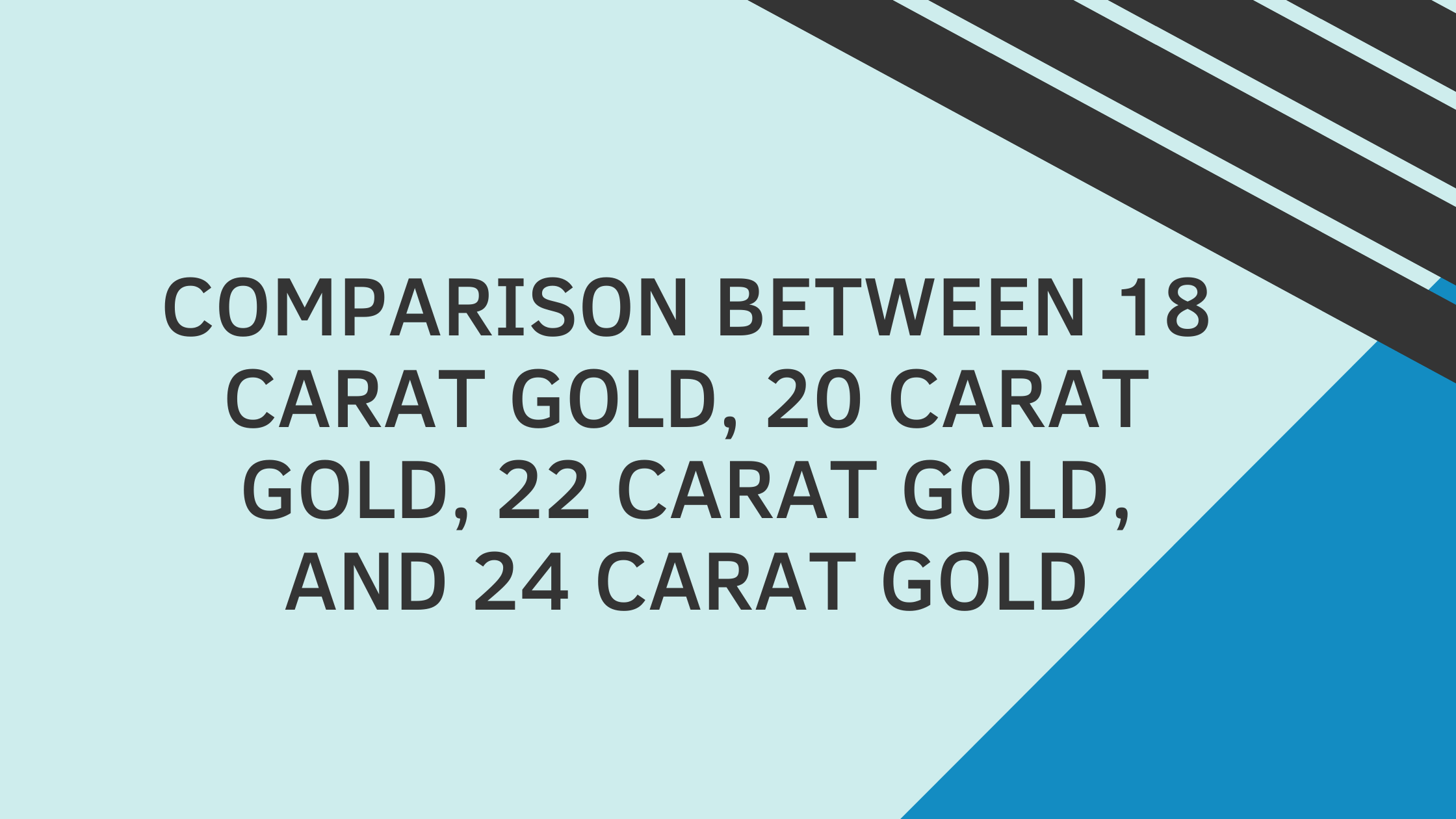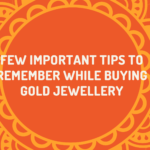Indians never hesitate to buy gold, whether it’s for a wedding or any other religious ceremony; all they need is an excuse. Gold is one of the most valuable and widely utilized commodities on the planet. One of the main reasons for its long-term appeal is that it does not rust and is tarnish-resistant since it does not react with moisture.
The beautiful shine and yellow colour make it ideal for jewellery. When it comes to purity, there are four different variations in gold, namely 18 Carat gold, 20 Carat gold, 22 Carat Gold, and 24 Carat Gold. Each of them has a unique mixture and are used for various purposes. This article examines the characteristics of each carat of gold and provides ample information for you to select among the four types.
Before diving right into the comparison, let us first understand the meaning behind ‘Carat’.
What do you mean by Carat?
Carat is a unit of measurement for the fineness (purity) of gold. The purity of a gold alloy is expressed as the number of gold parts it contains. A gold carat equals 1/24 part, or 4.1667 per cent, of the whole. Thus, 16-carat gold is made up of 16 parts gold and 8 parts alloying metal, while 24-carat gold is pure gold.
A medieval currency known as a mark gave birth to this way of displaying the relative quantity of gold. Since pure gold was too soft to be used to make marks, copper or other metals were added to make a hard alloy; the purity of the coin was then determined by the percentage of its carat weight contributed by gold.
What is the Contrast Between Different Carats of Gold?
| 24 carat Gold | 22 carat Gold | 20 carat Gold | 18 Carat Gold | |
| Purity | 99.9% | 91.67% | 83.3% | 75% |
| Purpose | Ideal for long-term investment | Ideal for use as jewellery or as an investment | Suitable for jewellery | Only suitable for use as a piece of jewellery |
| Used For | The pure gold 24K is used in medical and electrical applications | It’s used to make jewellery and coins | Used in making jewellery. It can be found in antique chains, rings, and earrings | Used in the creation of diamond and stone-encrusted jewellery |
| Price | Most Expensive | Less expensive than 24 Carat gold | Not commonly found now | Less expensive than the other three varieties of gold |
What is Meant by 24 Carat Gold?
24 Carat gold is often known as pure gold or 100% gold. This signifies that each of the gold’s 24 components is 100% pure gold with no trace of other metals. It’s known to be 99.9% pure and has a distinctive bright yellow colour. There is no greater kind of gold than 24K, which you should know before going to a dealer who claims to be selling you 25K or 26K gold.
As this is the purest kind of gold, it is more costly than 22K, 20K, or 18-carat gold. However, as compared to the gold of a lower cartage, this sort of gold has a reduced density, making it soft and flexible. As a result, it is unsuitable for traditional jewellery.
The majority of 24-carat gold coins and bars are purchased. 24 Carat gold is also utilized in electronics and medical devices.
What are Some of the Uses for 24-carat Gold?
As we know that 24 Carat gold is made entirely of gold and does not contain any other metal, it is more expensive than 22 or 18-carat gold. Due to its soft and malleable character, 224-carat gold is not used to produce jewellery items. It is extensively used to make gold bars, coins, technological devices, and medical equipment.
What is meant by 22 Carat Gold?
22 Carat gold jewellery means that 22 percent of the piece is gold, and the remaining two per cent is made up of other metals. This type of gold is frequently used in jewellery. Only 91.67 percent of 22-carat gold is pure gold, out of a total of 100%.
Metals like silver, zinc, nickel and other alloys make up the remaining 8.33%. The addition of metals makes the texture of gold tougher, resulting in more durable jewellery.
However, you should be aware that while 22-carat gold can be used to manufacture basic gold jewellery, it is not recommended for diamonds or densely studded jewellery.
What is Meant by 20 Carat Gold?
Gold in the 20K range is genuine gold with high purity. The number 20K refers to the purity of the gold, and it indicates that your item is 20 carats out of a maximum of 24 carats. It has an 83.3 percent gold content and a 16.7% alloy content.
The value of 20-carat gold is the same as the value of 833 gold. In today’s world, 20 Carat gold is quite rare. Instead, for this level of purity, 18-carat gold or 22 Carat gold are the traditional possibilities. 20 Carat gold is a form of gold that can be found in antique jewellery like antique chains, rings, and earrings.
What is Meant by 18 Carat Gold?
75 percent gold and 25% additional metals, such as copper or silver, make up 18-carat gold. Usually, 18-carat gold is used to make studded jewellery and other diamond jewellery. When compared to 24K and 22-carat gold, this type of gold is less expensive. The colour is a little dingy gold.
It’s easy to spot 18K jewellery because it’s stamped with the letters 18K, 18Kt, 18k, or a variation of these. 750, 0.75, or a stamp similar to these are sometimes stamped on 18-carat gold to indicate that the jewellery contains 75% gold.
What is the Purpose of 18-Carat Gold?
18-carat gold is made up of 75% gold and 25% alloy metals, making it extremely durable and robust. As a result, 18-carat gold is commonly used to create rings, watches, and other wearable jewellery. Its bright golden colour makes it ideal for engagement rings and other pieces of jewellery.
What are the Factors that you Must Consider While Selecting the Type of Gold for Jewellery?
That is contingent on your priorities. At the very least, you’ll want to think about the following:
Colour and Appearance
The appearance and colour of the ring will most likely be one of your top priorities. This is, for the most part, subjective. Bright yellow, for example, is favoured by people who desire a conventional or classical aesthetic, as well as persons with darker complexion tones. Here, 18k gold is the best option, although 14k gold with the correct alloying metal will suffice. You’ll need a lower carat rating and an alloying metal like palladium or platinum if you want white gold. You’ll need a 14k or 10k ring with copper as an alloying ingredient for rose gold.
Skin Discomfort and a Tactile Sensation
You should also think about how the ring feels on your finger and whether it can cause any discomfort. Allergies prevent millions of people from liking certain types of metal. Gold isn’t normally a problem; regardless of the quality of the gold you’re working with, it shouldn’t cause any problems.
As a result, higher purities are less prone to irritate the skin. Certain sorts of alloying metals cause problems. Zinc and nickel are the most common causes of skin irritation, but copper and silver can also cause discomfort. If you want to be sure, go with palladium or platinum and the highest carat ring you can buy.
Durability
Many people believe gold is quite durable. However, it is actually fragile and easily damaged. This is why 24 Carat gold jewellery is difficult to come across; it would be far too simple to scratch and deform. While 18k gold is gorgeous and pure, it is also the most vulnerable to wear and tear over time.
Gold with a lower carat value has better strength and durability. When they’re alloyed with metals that provide endurance, such as platinum, they become even stronger, albeit the cost may go up.
Expensiveness
Engagement rings, wedding bands, and other high-end jewellery can be rather costly. Your selections may be limited if you’re working with a small budget. The most expensive rings are usually made of 18k gold, with 10k gold being the cheapest alternative that is still of good quality. In terms of price and value, 14k gold is frequently an excellent middle-of-the-road alternative. You can also save money by selecting the proper alloying metal to match with the gold.
What is the Best Form of Gold and Why?
It all depends on why you’re buying gold. 22 Carat gold is a good option if you want ornamentation as well as an investment. When an investment is made in the form of jewellery or ornaments, however, the manufacturing costs and waste are deducted when the item is sold. Gold jewellery has a greater cost of production.
Gold biscuit sellers, on the other hand, are just interested in the gross profit and current gold prices. If you’re only interested in investing, 24 Carat gold is a better option. The finest form of gold is available in the form of gold biscuits and gold bars. Gold in its purest form can be purchased.
Which Gold is Best for Everyday Use?
As 22 Carat gold contains alloys like copper, zinc, and silver, it is perfect for everyday use. 91.6 percent gold and the remaining metal alloys make up 22 Carat gold, which ensures its toughness.
What are Gold Alloys and Gold Colours?
Gold alloys are metals that include zinc, copper, nickel, iron, cadmium, aluminium, silver, platinum, and palladium.
The only coloured pure metals are gold and copper. All other metals are white or grey in colour, although they affect the colour of gold alloys in different ways. Gold comes in four primary hues, depending on the alloy: yellow gold, white gold, rose gold, and green gold.
- Yellow gold is the most popular and is the colour most frequently associated with true gold. It’s a gold, silver, copper, and zinc alloy. It is hypoallergenic, meaning it is unlikely to induce an allergic reaction because it is combined with silver (another noble metal).
- White gold resembles silver or platinum in appearance. It’s an alloy of gold with platinum or palladium, and it’s a popular gold for jewellery. Nickel and zinc are also possible additions. White gold is exceptionally durable and scratch-resistant due to the hardness of platinum or palladium.
- The presence of copper gives rose gold its reddish hue. The alloy also contains silver. Copper and silver are both very inexpensive metals, making them a more economical option.
- Green gold is a combination of gold, silver, and occasionally copper. Its silver component gives it a very slight green tinge. It is the only alloy that occurs naturally. Electrum is a mineral found in the Earth’s crust that contains trace amounts of copper and other metals. Cadmium can also be used to make green gold.
FAQ
Which is preferable: 24-carat gold or 18-carat gold?
The 18K gold plating is made up of 75% pure gold and 25% additional metals for added hardness and strength, whilst the 24 carat gold plating is made up of 100% pure gold. 24K gold, on the other hand, is rarely used in jewellery since it is delicate and easily damaged.
Is it possible to wear 22K gold daily?
On the other side, the strength of a gold chain increases as the alloy content (copper, silver, and zinc) increases, with 22K or 916 being the best (91.6 percent gold). As a result, a 22k gold chain is the finest option for everyday wear.
Is it worthwhile to invest in 18K gold?
Overall, if you want gold jewellery that is as pure as possible while still being functional, 18K gold is a fantastic choice. However, if you need a really sturdy ring or are on a tight budget, this isn’t the ideal option.
What is the Gold Content of 18-Carat gold?
The purity of gold alloyed with other metals is measured in ‘cartage’. There are no other metals in 24-carat gold. Lower cartages contain less gold; for example, 18-carat gold includes 75% gold and 25% other metals, most commonly copper or silver.

























